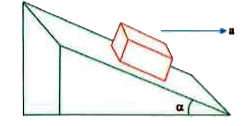A block A kept on an inclined surface just begins to slide if the inclination is 300. The block is replaced by another block B and it is found that it just begins to slide if the inclination is 400
mass of A> mass of B
mass of A<mass of B
mass of A = mass of B
all the three are possible
The correct Answer is:D
Step by step video, text & image solution for A block A kept on an inclined surface just begins to slide if the inclination is 30^0. The block is replaced by another block B and it is found that it just begins to slide if the inclination is 40^0 by Physics experts to help you in doubts & scoring excellent marks in Class 12 exams.
Updated on:21/07/2023Topper's Solved these Questions
- KINEMATICSBook:FIITJEEChapter:KINEMATICSExercise:MCQ (MULTIPLE CORRECT)
Explore 15 Videos
- KINEMATICSBook:FIITJEEChapter:KINEMATICSExercise:ASSERTION-REASON MCQ ( SINGLE CORRECT)
Explore 8 Videos
- KINEMATICSBook:FIITJEEChapter:KINEMATICSExercise:SECTION (II) : (SUBJECTIVE )
Explore 33 Videos
- HEAT AND TEMPERATUREBook:FIITJEEChapter:HEAT AND TEMPERATUREExercise:NUMERICAL BASES QUESTIONS
Explore 1 Video
- LAWS OF MOTIONBook:FIITJEEChapter:LAWS OF MOTIONExercise:COMPREHENSION-III
Explore 2 Videos
Similar Questions
A block A kept on an inclined surface just begins to slide if the inclination is 300. The block is replaced by another block B and it is found that it just begins to slide if the inclination is 400
View SolutionA block of mas M is resting on an inclined plane as shown in the figure. The inclination of the plane to the horizontal is gradually increased. It is found that when the angle of inclination is θ the block just begins to slide down the plane. What is the minimum force F applied parallel to the plane that would just make the block move up the plane ?

View Solution
Knowledge Check
A block X kept on an inclined surface just begins to slide if the inclination is θ1. The block is replaced by another block Y and it is found that it just begins to slide if the inclination is θ2(θ2>θ1). Then
AMass of X = mass of YBMass of X<mass of YCMass of X> mass of YDAll the three are possibleA block X kept on an inclined surface just begins to slide if the inclination is θ1 The block is replaced by another block Y and it is found that it just begins to slide if the inclination is θ2,(θ2>θ1) Then .
AMass of X= mass of YBMass of X< mass of YCMass of X> mass of YDAll the three are possible .A block kept on an inclined surface, just begins to slide if the inclination is 30∘. The block is replaced by another block B and it is just begins to slide if the inclination is 40∘, then :
AMass of A> mass of BBMass of A< mass of BCMass of A= mass of BDAll the three are possible
A block is kept on a frictionless inclined surface with angle of inclination α. The incline is given an acceeration 'a' to keep the block stationary Then 'a' is equal to
 .
.
View SolutionA block is kept on a frictionless inclined surface with angle of inclination α. The incline is given an acceleration 'a' to keep the block stationary. Then a is equal to

View SolutionA block is kept on a frictionless inclined surface with angle of inclination α. The incline is given an acceleration ‘a’ to keep the block stationary. Then 'a' is equal to

View SolutionA block is kept on a frictionless inclined surface with angle of inclination α'.

The incline is given an acceleration 'a' to keep the block stationary. Then a is equal to
View SolutionA block of mass 10 kg is placed on an inclined plane when the angle of inclination is 30∘. The block just begins to slide down the plane. The force of static friction is
View Solution

